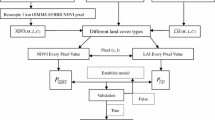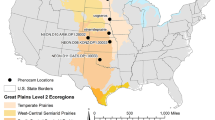Abstract
This paper presents a two-stage method for solving the problem of predicting phytomass and the corresponding two-component model of phytomass dynamics. At the first stage of the solution, a polymodel approach was applied to the selection and construction of a prognostic model of the Normalized Difference Vegetation Index (NDVI) dynamics. The classical regression technology was used, as well as cognitive modeling methods focused on solving poorly formalized problems—the technology of artificial neural networks and a fuzzy-probability approach. At the second stage, the transition from dimensionless NDVI indicators to metric values of the chlorophyll index was performed. The mass of autotrophic organs of plants was estimated from the chlorophyll index and the phytomass of the community was determined taking into account the peculiarities of its accumulation and distribution in plants. The development and verification of the model were carried out according to the NDVI and phytomass stocks of plant communities of Kolguyev Island. According to the simulation results, the stock of green phytomass of the simulated community is in the range from 215 to 242 g/m2, which is comparable in order of magnitude with the actual estimates—180–235 g/m2. A comparative analysis of modeling methods has been performed.





Similar content being viewed by others
REFERENCES
Aleksandrova, V.N. and Shamurin, V.F., Technique for determining the resources and structure of the phytomass of tundra communities, in Nauchnyi sovet po probleme “Kompleksnoe biogeotsenoticheskoe izuchenie zivoi prirodi i nauchnye osnovi ee ratsional’nogo osvoeniya i okhrani”. Sektsiya “Izuchenie biogeotsenozov tundry i lesotundry” (Scientific Council on the Problem “Integrated Biogeocenic Study of the Nature and Scientific Bases of Its Rational Exploration and Protection”), Leningrad: Nauka, 1972, pp. 60–64.
Andreev, V.N., Galaktionova, T.F., Govorov, P.M., Zakharov, P.I., Neustroeva, V.I., Savvinov, D.D., and Torgovkina E.E., Sezonnaya i pogodovaya dinamika fitomassy v subarkticheskoi tundre (Seasonal and Weather Dynamics of the Phytomass in Subarctic Tundra), Novosibirsk: Nauka, 1978.
Anisimov, O.A., Zhil’tsova, E.L., and Razzhivin, V.Yu., Predictive modeling of plant productivity in the Russian Arctic using satellite data, Izv., Atmos. Ocean. Phys., 2015, vol. 51, no. 9, pp. 1051–1059.
Aref’ev, S.P., Glazunov, V.A., Govorkov, V.A., Moskvichenko, D.V., Solov’ev, I.G., and Tsibul’skii, V.R., Models and analysis of the climatogenic dynamics of vegetation cover on the example of Yamal Peninsula data, Mat. Biol. Bioinf., 2017, vol. 12, no. 2, pp. 252–272.
Bazilevich, N.I., Biologicheskaya produktivnost' ekosistem Severnoi Evrazii (Biological Productivity of Northern Eurasian Ecosystems), Moscow: Nauka, 1993.
Bhatt, U.S., Walker, D.A., Raynolds, M.K., Bieniek, P.A., Epstein, H.E., Comiso, J.C., Pinzon, J.E., Tucker, C.J., and Polyakov, I.V., Recent declines in warming and vegetation greening trends over pan-Arctic tundra, Remote Sens., 2013, vol. 5, no. 9, pp. 4229–4254.
Bhatt, U.S., Walker, D.A., Raynolds, M.K., Bieniek, P.A., Epstein, H.E., Comiso, J.C., Pinzon, J.E., Tucker, C.J., Steele, M., Ermold, W., and Zhang, J., Changing seasonality of pan-Arctic tundra vegetation in relationship to climatic variables, Environ. Res. Lett., 2017, vol. 12. https://doi.org/10.1088/1748-9326/aa6b0b
Bondur, V.G., Methods for modeling radiation fields at the input of aerospace remote sensing systems, Issled. Zemli Kosmosa, 2000, no. 5, pp. 16–27.
Bondur, V.G., Modern approaches to processing large hyperspectral and multispectral aerospace data flows, Izv., Atmos. Ocean. Phys., 2014, vol. 50, no. 9, pp. 840–852. https://doi.org/10.1134/S0001433814090060
Bondur, V.G. and Chimitdorzhiev, T.N., Texture analysis of radar images of vegetation, Izv. Vyssh. Uchebn. Zaved., Geod. Aerofotos’emka, 2008a, no. 5, pp. 9–14.
Bondur, V.G. and Chimitdorzhiev, T.N., Remote sensing of vegetation by optical microwave methods, Izv. Vyssh. Uchebn. Zaved., Geod. Aerofotos’emka, 2008b, no. 6, pp. 64–73.
Bondur, V.G. and Starchenkov, S.A., Methods and programs for processing and classification of aerospace images, Izv. Vyssh. Uchebn. Zaved., Geod. Aerofotos’emka, 2001, no. 3, pp. 118–143.
Bondur, V.G. and Vorobev, V.E., Satellite monitoring of impact Arctic regions, Izv., Atmos. Ocean. Phys., 2015, vol. 51, no. 9, pp. 949–968. https://doi.org/10.1134/S0001433815090054
Bondur, V.G., Chimitdorzhiev, T.N., Dmitriev, A.V., and Dagurov, P.N., Spatial anisotropy assessment of the forest vegetation heterogeneity at different azimuth angles of radar polarimetric sensing, Izv., Atmos. Ocean. Phys., 2019, vol. 55, no. 9, pp. 926–934. https://doi.org/10.1134/S0001433819090093
Chang, T., Rasmussen, B.P., Dickson, B.G., and Zachmann, L.J., Chimera: A multi-task recurrent convolutional neural network for forest classification and structural estimation, Remote Sens., 2019, vol. 11, no. 7, id 768.
Dyukarev, E.A., Alekseeva, M.N., and Golovatskaya, E.A., Study of wetland ecosystem vegetation using satellite data, Izv., Atmos. Ocean. Phys., 2017, vol. 53, no. 9, pp. 1029–1041.
Elsakov, V.V., Satellite imagery for analyzing the chlorophyll index of tundra phytocenoses, Issled. Zemli Kosmosa, 2013, no. 1, pp. 60–70.
Elsakov, V.V. and Shanov, V.M., Current changes in the vegetation cover of Rangifer pastures in the Timan tundra according to analyzed data of satellite images, Sovrem. Probl. Distantsionnogo Zondirovaniya Zemli Kosmosa, 2019, vol. 16, no. 2, pp. 128–142.
Epstein, H., Bhatt, U., Raynolds, M., Walker, D., Forbes, B., Phoenix, G., Bjerke, J., Tommervik, H., Karlsen, S., Myneni, R., Park, T., Goetz, S., and Jia, J., Tundra Greenness, 2018. https://arctic.noaa.gov/Report-Card/ Report-Card-2018/ArtMID/7878/ArticleID/777/Tundra-Greenness.
Golovko, T.K., Dal’ko, I.V., Dymova, O.V., and Tabolenkova, D.N., The pigment complex of plants in northwestern Europe, Izv. Komi Nauchn. Tsentra Ural. Otd. Ross. Akad. Nauk, 2010, no. 1, pp. 39–46.
Hastie, T., Tibshirani, R., and Friedman, J., The Elements of Statistical Learning: Data Mining, Inference, and Prediction, Springer, 2013.
Ignat’ev, M.B., Marlei, B.E., Mikhailov, V.V., and Spesivtsev, A.V., Modelirovanie slaboformalizovannykh system na osnove yavnykh i neyavnykh ekspertnykh znanii (Simulation of Weakly Formalized Systems on the Basis of Implicit Expert Knowledge), St. Petersburg: Politekh-press, 2018.
Ivanova, K.V., NDVI dynamics for different classes of territorial units of typical tundras, Sovrem. Probl. Distantsionnogo Zondirovaniya Zemli Kosmosa, 2020, vol. 15, no. 5, pp. 194–202.
Karlsen, S.R., Anderson, H.B., van der Wal, R., and Hansen, B.B., A new NDVI measure that overcomes data sparsity in cloud-covered regions predicts annual variation in ground-based estimates of high Arctic plant productivity, Environ. Res. Lett., 2018, vol. 13, id 025011.
Lavrinenko, I.A., Dynamics of the vegetation cover of the Vaigach Island due to climate changes, in Sovrem. Probl. Distantsionnogo Zondirovaniya Zemli Kosmosa, 2013, vol. 8, no. 1, pp. 183–189.
Lavrinenko, I.A. and Lavrinenko, O.V., Climate change impact on the vegetation cover of the Barents Sea islands, Tr. Karel. Nauchn. Tsentra Ross. Akad. Nauk, 2013, no. 6, pp. 4–16.
Lavrinenko, O.V. and Lavrinenko, I.A., Zonal vegetation of East European lowland tundras, Rast. Ross., 2018, no. 32, pp. 35–108. https://doi.org/10.31111/vegrus/2018.32.35
Lavrinenko, O.V. and Lavrinenko, I.A., Stability of the composition and structure of tundra communities in a changing climate, in Tez. dokladov mezhdunarodnoi nauchnoi konferentsii “Kompleksnye issledovaniya prirodnoi sredy Arktiki i Antarktiki” (Proceedings of the International Scientific Conference “Integrated Studies of the Arctic and Antarctic Natural Environment”), St. Petersburg: GNTs RF AANII, 2020, pp. 387–391.
Landsat Surface Reflectance-derived Spectral Indices, Landsat Normalized Difference Vegetation Index. https://www.usgs.gov/land-resources/nli/landsat/landsat-normalized-difference-vegetation-index?qt-science_ support_page_related_con=0#qt-science_support_page_ related_con.
Li, P., Jiang, L., and Feng, Z., Cross-comparison of vegetation indices derived from Landsat-7 Enhanced Thematic Mapper Plus (ETM+) and Landsat-8 Operational Land Imager (OLI) sensors, Remote Sens., 2014, pp. 310–329. https://doi.org/10.3390/rs6010310
Matveeva, N.V. and Zanokha, L.L., Changes in vascular flora in Dickson settlement vicinity (Western Taymyr) from 1980 to 2012, Bot. Zh., 2017, vol. 102, no. 6, pp. 812–846.
Matveeva, N.V., Zanokha, L.L., and Yanchenko, Z.A., Changes in vascular plant flora in the area of the Taymyr biogeocenic field station (in the middle course of the Pyasina River, Western Taimyr) from 1970 to 2010, 2014, vol. 99, no. 8, pp. 841–867.
Medvedev, S.S., Fiziologiya rastenii (Plant Physiology), St. Petersburg: SPb GU, 2006.
Moiseev, N.N., Matematicheskie zadachi sistemnogo analiza (Mathematical Problems of System Analysis), Moscow: Nauka, 1981.
Pouliot, D., Latifovic, R., Pasher, J., and Duffe, J., Assessment of convolution neural networks for wetland mapping with Landsat in the central Canadian boreal forest region, Remote Sens., 2019, vol. 11, no. 7, id 772.
Raynolds, M., Walker, D., Epstein, H., Pinzon, J., and Tucker, C., A new estimate of tundra-biomphytomass from trans-Arctic field data and AVHRR NDV, Remote Sens. Lett., 2012, vol. 3, no. 5, pp. 403–411.
Shevyrnogov, A.P., Pisman, T.I., Kononova, N.A., Botvich, I.Yu, Larko, A.A., and Vysotskaya, G.S., Seasonal dynamics of vegetation on fallow lands in Krasnoyarsk forest steppe according to terrain and satellite data, Izv., Atmos. Ocean. Phys., 2019, vol. 55, no. 9, pp. 1353–1361.
Spesivtsev, A.V. and Domshenko, N.G., Expert as an “intellectual measuring and diagnostic system”, in Sb. dokl. XIII Mezhdunarod. konf. po myagkim vychisleniyam i izmereniyam (SCM-2010) (Proceedings of the XIII International Conference on Soft Computing and Measurements (SCM-2010)), St. Petersburg: SPbGETU LETI, 2010, vol. 2, pp. 28–34.
Tarchevskii, I.A., Osnovy fotosinteza (Basics of Photosynthesis), Moscow: Vysshaya shkola, 1977.
Tishkov, A.A., Belonovskaa, E.A., Vaisfeld, M.A., Glazov, P.M., Krenke, A.N., and Tertitskii, G.M., “Greening” of the tundra as a driver of recent dynamics of the Arctic biota, Arkt.: Ekol. Ekon., 2018, no. 2, pp. 31–44.
Tsel’niker, J.L. and Malkina, E.S., The chlorophyll index as an indicator of annual carbon accumulation by forest stands, Fiziol. Rast., 1994, vol. 41, no. 3, pp. 325–330.
USGS Earth Resources Observation and Science (EROS) Center Science Processing Architecture (ESPA) On Demand Interface (ESPA). https://espa.cr.usgs.gov/.
Voronin, P.Yu., Chlorophyll index and photosynthetic carbon sink in Northern Eurasia, Fiziol. Rast., 2015, vol. 53, no. 5, pp. 777–785.
Walker, D., Epstein, H., Jia, G., Balser, A., Copass, C., Edwards, E., Gould, W., Hollings, J., Knudson, J., Maier, H., Moody, A., and Raynolds, M., Phytomass, LAI, and NDVI in northern Alaska: Relationships to summer warmth, soil pH, plant functional types, and extrapolation to the circumpolar Arctic, J. Geophys. Res., 2003, vol. 108, no. D2, 8169. https://doi.org/10.1029/2001JD000986
Zuev, V.V., Korotkova, E.M., and Pavlinsky, A.V., Climate-related changes in the vegetation cover of the taiga and tundra of West Siberia over the period of 1982–2015 based on satellite data, Izv., Atmos. Ocean. Phys., 2020, vol. 56, no. 9, pp. 1072–1079.
Funding
This work was carried out with the support from budget themes nos. 0074-2019-0009, 0073-2019-0004, and АААА-А19-119032090096-4 and a grant from the Russian Science Foundation (no. 20-17-00160).
The development of an artificial neural network was also supported by a grant from the Russian Foundation for Basic Research, 19-37-90112.
Author information
Authors and Affiliations
Corresponding author
Ethics declarations
The authors declare that they have no conflicts of interest.
Additional information
Translated by P. Kuchina
Rights and permissions
About this article
Cite this article
Mikhailov, V.V., Spesivtsev, A.V., Sobolevsky, V.A. et al. Multimodel Evaluation of Phytomass Dynamics of Tundra Plant Communities Based on Satellite Images. Izv. Atmos. Ocean. Phys. 57, 1198–1210 (2021). https://doi.org/10.1134/S0001433821090553
Received:
Revised:
Accepted:
Published:
Issue Date:
DOI: https://doi.org/10.1134/S0001433821090553




